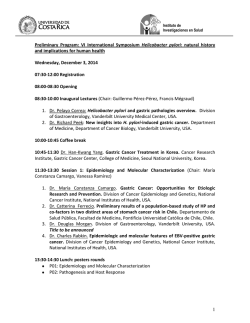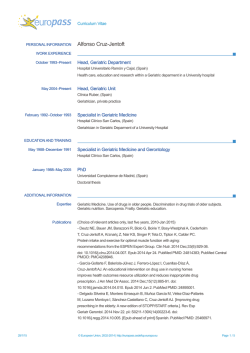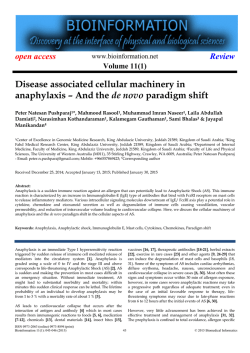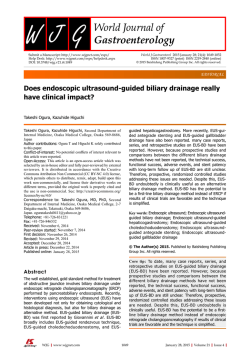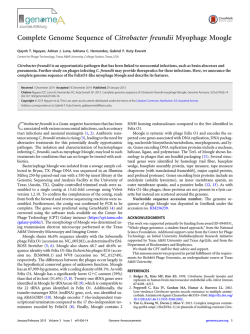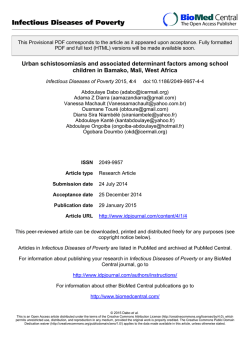
PDF (1903K) - World Journal of Gastroenterology
World J Gastroenterol 2015 January 28; 21(4): 1305-1314 ISSN 1007-9327 (print) ISSN 2219-2840 (online) Submit a Manuscript: http://www.wjgnet.com/esps/ Help Desk: http://www.wjgnet.com/esps/helpdesk.aspx DOI: 10.3748/wjg.v21.i4.1305 © 2015 Baishideng Publishing Group Inc. All rights reserved. META-ANALYSIS Accuracy of urea breath test in Helicobacter pylori infection: Meta-analysis Mazen Ferwana, Imad Abdulmajeed, Ali Alhajiahmed, Wedad Madani, Belal Firwana, Rim Hasan, Osama Altayar, Paul J Limburg, Mohammad Hassan Murad, Bandar Knawy Abstract Mazen Ferwana, Imad Abdulmajeed, Ali Alhajiahmed, Wedad Madani, Bandar Knawy, National and Gulf Center for Evidence-Based Health Practice, King Saud Bin Abdulaziz University for Health Sciences, Riyadh 11426, Saudi Arabia Belal Firwana, Rim Hasan, Department of Medicine, University of Missouri Columbia, Missouri, MO 65211, United States Belal Firwana, Rim Hasan, Knowledge and Evaluation Research Unit, Mayo Clinic, Rochester, MN 65212, United States Osama Altayar, Knowledge and Evaluation Research Unit, Mayo Clinic, Rochester, MN 55905, United States Osama Altayar, Department of Internal Medicine, Allegheny General Hospital, Pittsburg, PA 55905, United States Paul J Limburg, Division of Gastroenterology, Mayo Clinic, Rochester, MN 55905, United States Mohammad Hassan Murad, Division of Preventive Medicine, Mayo Clinic, Rochester, MN 55905, United States Open-Access: This article is an open-access article which was selected by an in-house editor and fully peer-reviewed by external reviewers. It is distributed in accordance with the Creative Commons Attribution Non Commercial (CC BY-NC 4.0) license, which permits others to distribute, remix, adapt, build upon this work non-commercially, and license their derivative works on different terms, provided the original work is properly cited and the use is non-commercial. See: http://creativecommons.org/ licenses/by-nc/4.0/ Correspondence to: Mazen Ferwana, MD, ABFM, JBFM, PhD, National and Gulf Center for Evidence-Based Health Practice, King Saud Bin Abdulaziz University for Health Sciences, King Abdulaziz Medical City, National Guard Health Affairs, P.O. Box 22490, Mail code 3120, Riyadh 11426, Saudi Arabia. [email protected] Telephone: +966-11-4291167 Fax: +966-11-4291193 Received: March 11, 2014 Peer-review started: March 11, 2014 First decision: March 27, 2014 Revised: May 19, 2014 Accepted: June 14, 2014 Article in press: June 17, 2014 Published online: January 28, 2015 WJG|www.wjgnet.com AIM: To quantitatively summarize and appraise the available evidence of urea breath test (UBT) use to diagnose Helicobacter pylori (H. pylori ) infection in patients with dyspepsia and provide pooled diagnostic accuracy measures. METHODS: We searched MEDLINE, EMBASE, Cochrane library and other databases for studies addressing the value of UBT in the diagnosis of H. pylori infection. We included cross-sectional studies that evaluated the diagnostic accuracy of UBT in adult patients with dyspeptic symptoms. Risk of bias was assessed using QUADAS (Quality Assessment of Diagnostic Accuracy Studies)-2 tool. Diagnostic accuracy measures were pooled using the random-effects model. Subgroup 13 14 analysis was conducted by UBT type ( C vs C) and by measurement technique (Infrared spectrometry vs Isotope Ratio Mass Spectrometry). RESULTS: Out of 1380 studies identified, only 23 met the eligibility criteria. Fourteen studies (61%) evaluated 13 14 C UBT and 9 studies (39%) evaluated C UBT. There was significant variation in the type of reference standard tests used across studies.Pooled sensitivity was 0.96 (95%CI: 0.95-0.97) andpooled specificity was 0.93 (95%CI: 0.91-0.94). Likelihood ratio for a positive test was 12 and for a negative test was 0.05 with an area under thecurve of 0.985. Meta-analyses were associated with a significant statistical heterogeneity that remained unexplained after subgroup analysis. The included studies had a moderate risk of bias. CONCLUSION: UBT has high diagnostic accuracy for detecting H. pylori infection in patients with dyspepsia. The reliability of diagnostic meta-analytic estimates however is limited by significant heterogeneity. 1305 January 28, 2015|Volume 21|Issue 4| Ferwana M et al . Accuracy of UBT in H. pylori infection Key words: Helicobacter pylori ; Dyspepsia; Breath tests; Urea/analysis; Diagnosis; Sensitivity; Specificity; Gastritis; Positive predictive value; Negative predictive value titers, stool antigen analysis, and the urea breath test (UBT). Given the user-friendly, non-invasive features of UBT, this detection method may be preferred in many clinical settings. However, to date, the performance characteristics of UBT have been inconsistently described and remain incompletely defined. UBT can play a useful role in the diagnostic eva luation of dyspeptic patients who have comorbidities that increase their risk of upper endoscopy, are intolerant to upper endoscopy, or have known or suspected gastric atrophy. Stool antigen testing can also be used to non-invasively detect active H. pylori infection, and the choice of diagnostic modality depends on factors such as cost, laboratory infrastructure, and concomitant use of medications such as proton pump inhibitors or antibiotics that may influence test results. Serum antibody test results can vary by geographic region, and may stay positive for a prolonged period following H. pylori eradication, thereby limiting the clinical utility for determining the presence or absence of current [4] infection . There are two UBTs available and gained Food and 13 14 Drug Administration approval: C and C tests. Both tests are affordable and can provide real-time results. 13 Some physicians may prefer the C test as it is non14 radioactive compared to C which uses a radioactive isotope, especially in young children and pregnant women, though dose of radianis very minimal (about [5] 1 microCi) ; the dose of radiation is the dose of 14 C-UBT with the mini dose equals to 1 microCi (37 [6] kbq) which has a high diagnostic accuracy . UBT is indicated to confirm H. pylori colonization and to monitor its eradication. Positive UBT indicates an active H. pylori infection which require treatment or further confirmation with invasive procedures. Initial treatment for H. Pylori consist of either triple, quadruple, or sequential therapy regimens, which all of them includes a proton pump inhibitor plus various antibiotic regimen; treatment periods generally varied [4] from 7 to 14 d . In this systematic review and meta-analysis, we aimed at summarizing data and appraising the relevant articles of UBT for diagnosis of H. pylori infection in dyspeptic patients and provide pooled diagnostic accuracy measures. © The Author(s) 2015. Published by Baishideng Publishing Group Inc. All rights reserved. Core tip: Urea breath test (UBT) is a commonly used non-invasive test to diagnose Helicobacter pylori (H. pylori ) infection in patients with dyspepsia. Multiple trials are available in literature, but they reported different diagnostic accuracy estimates. We conducted systemic review and meta-analysis to explore the available evidence and provide pooled diagnostic accuracy measures. Our meta-analysis showed that UBT has high diagnostic accuracy for detecting H. pylori infection in patients with dyspepsia. Given the potentially preventable diseases associated with chronic, untreated H. pylori infection, more widespread adoption of UBT testing may be indicated. Ferwana M, Abdulmajeed I, Alhajiahmed A, Madani W, Firwana B, Hasan R, Altayar O, Limburg PJ, Murad MH, Knawy B. Accuracy of urea breath test in Helicobacter pylori infection: Meta-analysis. World J Gastroenterol 2015; 21(4): 1305-1314 Available from: URL: http://www.wjgnet.com/1007-9327/full/ v21/i4/1305.htm DOI: http://dx.doi.org/10.3748/wjg.v21.i4.1305 INTRODUCTION Helicobacter pylori (H. pylori) is a gram-negative bacterium found on the luminal surface of the gastric epithelium. It was first isolated by Warren and Marshall in 1983. It induces chronic inflammation of the underlying mucosa. The infection is usually contracted in the first few years of life and tends to persist indefinitely unless treated. At least 50% of the world’s population is thought to carry H. pylori. The organism can survive in the acidic environment of the stomach partly owing to its remarkably high urease activity. Urease converts the urea present in gastric juice to alkaline ammonia and carbon [1] dioxide . Although the full spectrum of pathogenesis is currently unknown, H. pylori has been linked to a variety of upper gastrointestinal disorders. Reported symptoms of H. pylori infection are relatively nonspecific, such as epigastric pain, postprandial fullness, bloating, nausea, and vomiting, along with signs of [2,3] acid hypersecretion and delayed gastric emptying . In addition, infection with H. pylori is linked to three important upper gastrointestinal diseases: duodenal or gastric ulcers, gastric cancer, and gastric mucosaassociated lymphoid-tissue lymphoma. Many invasive and non-invasive methods can be used to diagnose H. pylori infection, including endoscopy with biopsy, serology for immunoglobulin WJG|www.wjgnet.com MATERIALS AND METHODS Search and analysis methods, eligibility criteria, and the outcomes of interest were specified in advance in a protocol developed by study investigators. Inclusion criteria We included cross-sectional studies with consecutive patients that evaluated the diagnostic accuracy of UBT in adult patients with dyspeptic symptoms. We 13 14 included articles that compare C-UBT or C-UBT 1306 January 28, 2015|Volume 21|Issue 4| Ferwana M et al . Accuracy of UBT in H. pylori infection H. pylori test with a reference standard which is H. pylori (culture and/or histological examination) and/ or not (serologic test either blood or stool). We excluded studies that enrolled children or adolescents under 18 year of age, subjects who presented for reasons other than dyspeptic symptoms, bleeding peptic ulcer, complicated dyspeptic cases that need surgery, those who received previous therapy for H. pylori within the last 3 mo, or long term use of corticosteroids and immunosuppressant drugs and screening studies. Only articles presenting true positive, true negative, false positive and false negative data were included in the present study. Studies where data was missing and studies with high risk of bias were excluded. There was no inclusion restriction on the type of UBT 13 14 performed. Both C and C types where included. Studies where the UBT was performed through an invasive method were excluded. inclusion in the systematic review. It consists of four key domains covering patient selection, index test, reference standard, and flow of patients through the study and timing of the index test(s) and reference standard. Each domain is assessed in terms of the risk of bias and the first three are also assessed in terms of concerns regarding applicability. Risk of bias is judged as “low”, “high”, or “unclear”. If all signaling questions for a domain are answered “yes” then risk of bias can be judged “low”. If any signaling question is answered “no” this flags the potential for bias. We considered low risk of bias in different domains as follows: Patient selection if non-complicated dyspeptic patients were enrolled in consecutively. Index test, where it was interpreted independent from the reference standard. Reference standard, when it correctly classifies H. pylori and non-H. pylori. Flow and time, the appropriate interval between index test and the reference standard is within 7 d, and breathing samples were collected within 30 min. Search strategy Meta-analysis UBT variants A librarian searched electronic databases for pub lished and in-press studies from 1990 (the date where UBT became available) through November 2013 including PubMed, EMBASE, LILACS and Co chrane databases. The search terms used were “H. pylori”, “Helicobacter pylori”, “Helicobacter infection”, “gastritis”, “dyspepsia”, “breath test”, “urea breath 13 14 test”, “UBT”, “ C-UBT” and “ C-UBT” with its MeSH terms (Medical Subject Headings) and keywords. We used Boolean operator (OR) to combine synonyms and (AND) to combine the cases with tests. No lan guage restriction was applied. Reference lists were also scanned. The meta-analysis was conducted using Meta[8] Disc 1.4 . Random effect model was followed in all analyses. The diagnostic accuracy measures used in the analysis were sensitivity, specificity, likelihood ratio for positive and negative test (LR+ and LR-), receiver operating characteristics (ROC) curve, and diagnostic odds ratio. We assessed heterogeneity using the I-squared statistic and Q test. Publication bias was conducted using the Deeks’ funnel plot asymmetry test, with P-value < 0.05 for the slope coefficient [9] indicating significant asymmetry . Subgroup and sensitivity analyses Study and data selection To explore the robustness of our results and evaluate for potential causes of heterogeneity, we conducted several a priori determined analyses. We tested the bivariate mixed effects regression model to determine if results were robust to the correlation between sensitivity and specificity. Bivariate analysis were conducted as implemented in STATA version 12.0 [10] (StataCorp, College Station, TX, United States) . We also conducted subgroup analyses based on the risk of bias in the included studies as it pertains to the various domains of QUADAS-2 tool (such as for the index test and the gold standard 13 test). We evaluated if the type of UBT test ( C vs 14 C) or measurement technique (isotope ration mass spectrometry vs infrared mass spectrometry) affected the pooled estimates. We conducted an interaction test for subgroup analyses as suggested [11] by Altman and Bland and there was no statistically significant difference to suggest a subgroup effect. Two authors (MF, WM) screened titles and abstracts for inclusion criteria. Full text articles were retrieved for relevant articles. An abstraction format developed by authors that includes: study citation, author name and year of publication, patients’ mean age and other baseline characteristics, UBT variant, gold standard used, time between the test and gold standard, description of the cases, and diagnostic study data (numbers of true positive, false positive, false negative, and true negative test results). Disagreement was resolved by consensus. Quality assessment Two reviewers (MF and IY) independently assessed the quality of the included studies using the QUADAS (Quality Assessment of Diagnostic Accuracy Studies)-2 [7] instrument . This tool is designed to assess the quality of primary diagnostic accuracy studies for WJG|www.wjgnet.com 1307 January 28, 2015|Volume 21|Issue 4| Ferwana M et al . Accuracy of UBT in H. pylori infection 14 studies (39%) used C UBT. The included studies were conducted in 16 countries, however all but one [12] were published in English (Spanish) . The mean age across studies was (40-59 year) and female gender distribution was (13%-74%). There was variation (10 folds) in the type of reference standard tests used by different studies (Table 2). Seven studies (30.4%) used one reference standard starting with either histopathology or culture at first and only used subsequent tests if the first test was negative (histopathology in three [13-15] [16-19] studies , and culture in four studies ). Two [20,21] studies (8.7%) used histopathology or culture, [12,22-24] nine studies (39.1%) used two combined tests (histopathology and rapid urease test “RUT” in four studies, histopathology and serology in one [25] [26] study , histopathology and culture in one study , [27-29] and any two tests in three studies . Four [30-33] studies (17.4%) used three combined tests, [3] and one study (4.3%) used four combined tests as reference standard. Histopathology is the most common approach when combined tests were used. [3,27,31] In three studies , UBT was part of combined reference standards. Potentially relevant articles identified from all searches (n = 1380): PubMed: 1227 Embase:112 LILAC: 38 Cochrane: 3 Reference excluded after initial screening (n = 859) Article selected for abstract review (n = 521) Articles excluded (n = 470): Duplication in publication (258) No comparison against reference standard (89) Review (123) Articles met eligibility criteria (n = 51) Pooled estimate for UBT (Combined 13C and 14C) Article excluded (n = 28): Usage of invasive procedure (2) Used with GI bleeding or after surgery (2) Normal patients screening (3) Insufficient information (7) No comparison against reference standard (14) UBT had high sensitivity and specificity 0.96 (95%CI: 0.95-0.97) and 0.93 (95%CI: 0.91-0.94); respectively. LR+ and LR- were 12.32 (95%CI: 8.38-18.1) and 0.05 (95%CI: 0.03-0.07) respectively. The AUC was 0.985. Forest plots are depicted in Figure 3. There was no evidence of publication bias (P > 0.05 using Deeks’ asymmetry test). 23 articles met the inclusion criteria and included in meta-analysis Test of heterogeneity Inconsistency between results for sensitivity and specificity among studies were 72.9% and 72% respectively with statistically significant Q test (P < 0.05). Heterogeneity could be explained by either clinical or methodological variation; the performed subgroup analyses could not explain the difference. Figure 1 Study selection process. RESULTS Search results Subgroup analysis The initial search yielded 1380 studies that were potentially relevant; of which, 23 studies that enrolled a total of 3999 participants were finally included. The study selection process is depicted in Figure 1 including causes of exclusion. More than 50% of quality assessment items articles have low risk of bias of all domains. The agreement between risk of bias assessment between reviewers were 70%, disagreement was resolved by discussion and consensus. Figure 2 visually summarizes the risk of biasin the included studies. 13 Use of infrared in UBT: Out of total 23 studies, 6 studies used infrared technique in measuring urea level. Both methods showed high performance against the gold standard test without a significant difference. Subgroup analysis based on the risk Characteristics of included studies Table 1 shows the characteristics of all included studies. Of the 23 studies, 14 studies (61%) com 13 pared C UBT with a reference standard, while 9 WJG|www.wjgnet.com 14 C UBT vs C UBT: Of the total studies recruited in 13 this systematic review, 14 were conducted using C 14 UBT vs 9 using C UBT (Table 3). Both versions of the test showed high performance against the Gold standard test without a significant difference. Figures are shown in online supplement materials (Figure 3). Interaction test for subgroup analyses as suggested by [11] Altman and Bland showed no statistically significant difference to suggest a subgroup effect (P = 0.87). 1308 January 28, 2015|Volume 21|Issue 4| Ferwana M et al . Accuracy of UBT in H. pylori infection Low High Quadas-2 domain Flow and timing Unclear Reference standard Index test Patient selection 0% 20% 40% 60% 80% 100% Proportion of studies with low, high or unclear Risk of bias 0% 20% 40% 60% 80% 100% Proportion of studies with low, high or unclear Concerns regarding applicability Figure 2 Risk of bias assessment. Table 1 Baseline characteristics of the included studies Ref. Country Year No. of patients Allardyce et al[13] New 1997 Zealand 63 Crosssectional 14 Bruden et al[16] Calvet et al[27] Estonia 2011 280 Spain 2009 199 Crosssectional Crosssectional Chen et al[29] Taiwan 2003 586 Chen et al[25] Japan 2000 169 Gatta et al[30] Italy 2003 Gomes et al[22] Brazil Gomollon et al[17] Gurbuz et al[23] Hahn et al[31] Hilker et al[14] Reference standard Mean age (mean ± SD) Females UBT threshold Time No Histo or (Biopsy and rapid urea test) 56.5 26 41% 82% DPM 13 No 53.5 185 66% ≥ 5% 13 Yes 48.2 ± 14.2 107 53% 8.5% 20 min after drinking solution Crosssectional Crosssectional 13 Yes Culture or (Histo and RUT) Any two positive (Histopathology, RUT, UBT, and fecal serology) Culture alone or RUT 30 min and 60 min post ingestion NA 45.7 ± 13.3 280 46.6% ≥ 2% 13 No Combined (Histo and serology) 53.9 ± 15.7 68 40% 2.5% 200 Crosssectional 13 No 53 ± 13 113 56% NA 2002 137 14 No 46.7 ± 16.6 67 45% Spain 2003 314 Crosssectional Crosssectional 13 No 54.1 ± 18 168 53.5% 1000-2000 CPM ≥ 5% 30 min post ingestion 30 min post ingestion Turkey 2005 65 14 No 42.4 ± 15.5 46 67.7% > 50 CPM United 2000 States Germany 1996 100 Crosssectional Crosssectional Crosssectional Crosssectional Crosssectional Crosssectional 13 No 58.8 ± 14 9 13.4% > 2.3% 13 No Combined (Histology and rapid urease) and/or culture Combined (Histo and RUT) Culture and/or Combined (Histo and RUT) Combind tests (Histo and RUT) Combined (Histo, UBT and serology) Histo 20 min after drinking solution 20 min after normal respiration 30 min post ingestion 46 106 60.9% > 250 13 Yes Histo and culture 46.5 379 62.7% > 5% 14 No -- 77 50% > 6% 13 No Combined (Culture, RUT and histo) Culture and/or combined (Histo and RUT) Combined; any 2 positive ( RUT, PCR and histo) Histology 45 ± 15 49 55.6% > 4.22% 10 min after drinking solution 30 min after administration 30 min after administration 30 min after administration 30 min after administration 30 min after administration 45 ± 13 59 66% 41 ± 14 56 74.6% 100 DPM NA 55 44 55% 4.8% 39.7 ± 14.1 81 47% 3.3% 15 min after drinking solution Every 15 min for 1 h after ingestion of the urea solution 174 Study design UBT Infrared 13 14 ( C/ C) assisted C C C C C C C C C C C van der Hulst Italy et al[26] Marshall et United al[32] States Ortiz-Olvera Mexico Nayeli et al[18] 1999 544 1990 153 2007 88 Ozdemir et al[28] Turkey 2008 89 Crosssectional 14 No Oztürk et al[15] Turkey 2003 75 14 No Peng et al[19] Taiwan 2009 100 13 Yes Perri et al[20] Belgium 1998 172 Crosssectional Crosssectional Crosssectional 13 No WJG|www.wjgnet.com C C C C C C C Culture or combind (Histo and RUT) Histo and/or culture 1309 > 25 CPM 10 min after as Heliprobe drinking solution January 28, 2015|Volume 21|Issue 4| Ferwana M et al . Accuracy of UBT in H. pylori infection 2002 92 Crosssectional 14 No Rasool et al[24] Pakistan 2007 94 Crosssectional 14 No 2000 100 Crosssectional 13 Yes Surveyor et Australia 1989 al[21] Valdeperez et Spain 2003 al[12] 63 Crosssectional Crosssectional 14 No Combined (Culture, serology, UBT and urine test for C-urea) Two reference tests. Patient did both separately: (1) Histo; (2) RUT Combined 3 tests (Histo, UAT and culture) Histo and/or culture 13 No Histo and RUT Kopański et al[3] Riepl et al[33] Poland Austria 85 C C C C C 45.5 36 39% > 5% 30 min after administration 40.8 ± 12.8 34 36% > 50 CPM After 10 min 51.6 ± 1.4 49 49% > 4% NA 58.8 ± 14.5 30 47% NA Every 5 min for 30 min 30 min after administration 41.6 44 50.5% NA Histo: Histopathology; RUT: Rapid urea test; UAT: Urea antigen; CLO: The CLOtest™ (Ballard Medical Products, Draper, UT, United States) was used for RUT; PCR: Polymerase chain reaction; NA: Not available; CPM: Counts per min; UBT: Urea breath test; DPM: Disintegrations per minute. A Sensitivity (95%CI) 2011 Bruden 0.94 (0.88-0.97) 2009 Calvet 0.90 (0.83-0.95) 2009 Peng 1.00 (0.93-1.00) 2008 Ozdemir 0.97 (0.88-1.00) 2007 Rasool 0.92 (0.83-0.97) 2007 Nayeli 0.90 (0.79-0.97) 2005 Gurbuz 0.90 (0.73-0.98) 2003 Chen 0.97 (0.95-0.99) 2003 Valdeperez 0.92 (0.83-0.97) 2003 Ozturk 1.00 (0.93-1.00) 2003 Gatta 1.00 (0.97-1.00) 2003 Gomollon 0.98 (0.96-1.00) 2002 Radwanska 1.00 (0.95-1.00) 2002 Gomes 0.97 (0.93-0.99) 2000 Hahn 1.00 (0.40-1.00) 2000 Riepl 0.81 (0.65-0.92) 2000 Chen 1.00 (0.97-1.00) 1999 Hulst 0.95 (0.91-0.97) 1998 Perri 0.96 (0.91-0.99) 1997 Allardyce 1.00 (0.86-1.00) 1996 Hilker 1.00 (0.95-1.00) 1991 Marshall 0.97 (0.92-0.99) 1989 Surveyor 0.94 (0.79-0.99) Pooled sensitivity = 0.96 (0.95-0.97) 2 χ = 81.19; df = 22 (P = 0.0000) 2 Inconsistency (I ) = 72.9% 0 0.2 0.4 0.6 Sensitivity 0.8 1 B Specificity (95%CI) 2011 Bruden 0.83 (0.76-0.89) 2009 Calvet 0.90 (0.81-0.95) 2009 Peng 0.85 (0.72-0.94) 2008 Ozdemir 1.00 (0.88-1.00) 2007 Rasool 0.93 (0.76-0.99) 2007 Nayeli 0.93 (0.76-0.99) 2005 Gurbuz 0.78 (0.61-0.90) 2003 Chen 0.96 (0.93-0.98) 2003 Valdeperez 1.00 (0.82-1.00) 2003 Ozturk 0.80 (0.59-0.93) 2003 Gatta 0.99 (0.94-1.00) 2003 Gomollon 1.00 (0.94-1.00) 2002 Radwanska 0.89 (0.67-0.99) 2002 Gomes 0.95 (0.77-1.00) 2000 Hahn 0.86 (0.75-0.93) 2000 Riepl 0.90 (0.80-0.96) 2000 Chen 0.96 (0.81-1.00) 1999 Hulst 0.94 (0.91-0.97) 1998 Perri 0.98 (0.89-1.00) 1997 Allardyce 0.95 (0.83-0.99) 1996 Hilker 0.96 (0.90-0.99) 1991 Marshall 1.00 (0.93-1.00) 1989 Surveyor 0.93 (0.76-0.99) Pooled sensitivity = 0.93 (0.91-0.94) 2 χ = 78.64; df = 22 (P = 0.0000) 2 Inconsistency (I ) = 72.0% 0 0.2 0.4 0.6 Sensitivity WJG|www.wjgnet.com 0.8 1 1310 January 28, 2015|Volume 21|Issue 4| Ferwana M et al . Accuracy of UBT in H. pylori infection C Positive LR (95%CI) 2011 Bruden 5.46 (3.78-7.88) 2009 Calvet 8.63 (4.63-16.05) 2009 Peng 2008 Ozdemir 59.42 (3.80-929.32) 2007 Rasool 12.94 (3.40-49.28) 2007 Nayeli 13.53 (3.54-51.77) 2005 Gurbuz 2003 Chen 25.91 (13.12-51.14) 2003 Valdeperez 36.72 (2.38-567.43) 2003 Ozturk 2003 Gatta 2003 Gomollon 2002 Radwanska 2002 Gomes 2000 Hahn 2000 Riepl 8.11 (3.95-16.65) 2000 Chen 18.60 (3.92-88.23) 1999 Hulst 16.59 (9.97-27.61) 1998 Perri 45.13 (6.49-313.87) 1997 Allardyce 15.68 (4.72-52.14) 1996 Hilker 21.86 (8.86-53.91) 1991 Marshall 96.67 (6.13-1524.50) 1989 Surveyor 12.66 (3.33-48.17) 6.34 (3.28-12.24) 4.03 (2.16-7.53) 4.68 (2.23-9.83) 58.41 (11.95-285.47) 121.80 (7.70-1925.75) 7.95 (2.49-25.34) 21.43 (3.16-145.44) 6.06 (3.15-11.68) Random effects model Pooled positive LR = 12.32 (8.38-18.10) Cochran-Q = 81.37; df = 22 (P = 0.0000) 2 Inconsistency (I ) = 73.0% 2 Tau = 0.5169 0.01 1 Positive LR 100 D Negative LR (95%CI) 2011 Bruden 0.08 (0.04-0.15) 2009 Calvet 0.11 (0.06-0.19) 2009 Peng 0.01 (0.00-0.17) 2008 Ozdemir 0.04 (0.01-0.14) 2007 Rasool 0.08 (0.03-0.19) 2007 Nayeli 0.11 (0.05-0.24) 2005 Gurbuz 0.13 (0.04-0.39) 2003 Chen 0.03 (0.02-0.05) 2003 Valdeperez 0.08 (0.04-0.19) 2003 Ozturk 0.01 (0.00-0.21) 2003 Gatta 0.00 (0.00-0.07) 2003 Gomollon 0.02 (0.01-0.04) 2002 Radwanska 0.01 (0.00-0.12) 2002 Gomes 0.03 (0.01-0.08) 2000 Hahn 0.12 (0.01-1.63) 2000 Riepl 0.21 (0.11-0.41) 2000 Chen 0.00 (0.00-0.06) 1999 Hulst 0.06 (0.03-0.09) 1998 Perri 0.04 (0.02-0.10) 1997 Allardyce 0.02 (0.00-0.33) 1996 Hilker 0.01 (0.00-0.11) 1991 Marshall 0.03 (0.01-0.09) 1989 Surveyor 0.07 (0.02-0.26) Random effects model Pooled negative LR = 0.05 (0.03-0.07) Cochran-Q = 60.63; df = 22 (P = 0.0000) 2 Inconsistency (I ) = 63.7% 0.01 1 Negative LR 100 2 Tau = 0.4196 Figure 3 Pooled urea breath test result. A: Overall sensitivity; B: Overall specificity; C: Overall likelihood ratio for positive test; D: Overall likelihood ratio for negative test. of bias. Figures are shown in online supplement materials (Figure 2). There was no significant difference in diagnostic accuracy measures based on the risk of bias in terms of the key domains of patient selection, index test, reference standard, and flow of patients through the study and timing of the index test and reference standard. Interaction test for subgroup analyses showed no statistically significant difference to suggest a subgroup effect (P = 0.23). WJG|www.wjgnet.com Sensitivity analysis using bivariate model: Diag nostic accuracy measures were similar under the bivariate model and meta-analysis results appeared robust to the choice of model. DISCUSSION UBT is a noninvasive test for diagnosis of gastric H. pylori infection. Twenty-three studies for both UBT 13 14 C and C for detection of H. pylori infection in 1311 January 28, 2015|Volume 21|Issue 4| Ferwana M et al . Accuracy of UBT in H. pylori infection Table 2 Test values of included studies Table 3 Subgroup analysis Ref. TP FP FN TN Total Allardyce et al[13] Bruden et al[16] Calvet et al[27] Chen et al[29] Chen et al[25] Gatta et al[30] Gomes et al[22] Gomollon et al[17] Gurbuz et al[23] Hahn et al[31] Hilker et al[14] van der Hulst et al[26] part 1 van der Hulst et al[26] part 2 Marshall et al[32] Ortiz-Olvera Nayeli et al[18] Ozdemir et al[28] Oztürk et al[15] Peng et al[19] Perri et al[20] Kopański et al[3] Rasool et al[24] Riepl et al[33] Surveyor et al[21] Valdeperez et al[12] 24 131 102 361 135 113 112 249 26 4 76 255 161 101 46 57 48 53 121 75 61 30 30 61 2 24 9 8 1 1 1 0 8 9 4 14 3 0 2 0 5 7 1 2 2 7 2 0 0 9 11 10 0 0 3 4 3 0 0 14 12 3 5 2 0 0 5 0 5 7 2 5 37 116 77 205 26 86 21 61 28 54 94 231 72 49 28 30 20 40 46 17 26 63 25 19 63 280 199 584 162 200 137 314 65 67 174 514 248 153 81 89 73 100 173 94 94 107 59 85 Subgroup Sensitivity Specificity 14 9 5 18 0.96 (0.95-0.97) 0.97 (0.95-0.98) 0.95 (0.93-0.96) 0.97 (0.96-0.98) 0.94 (0.92-0.95) 0.91 (0.87-0.94) 0.93 (0.91-0.95) 0.93 (0.91-0.95) UBT: Urea breath test. is an expensive test. Strengths and limitations The primary strength of this study relates to the search of electronic databases for relevant articles and the careful appraisal of study quality. The limitations mainly relate to dealing with aggregate data that limits our ability to provide estimates based on patient-level characteristics and pre-test risk level. Another significant limitation relates to heterogeneity that was unexplained despite multiple subgroup analyses. The observed heterogeneity can be attributed to several factors. The urease activity of the oral flora can affect the reading of the UBT; this can be accounted for by asking the patient to wash the mouth before conducting the test. Other authors suggested the use of Nasogastric tube. The cut off value and the time to take the reading after the meal ingestion was not clearly stated in many of the studies involved. The nature of the radioisotope meal and individual patient characteristics such as anthropometric measures, sex and age might have also contributed to within as well as between studies variability. All these factors could have contributed to the persistence of heterogeneity even after 13 14 adjusting for UBT type ( C vs C) and technique of measurement (radioisotope mass spectrometry vs infrared spectrometry) in subgroup analysis. In conclusion, UBT has high diagnostic accuracy for detecting H. pylori infection in patients with dyspepsia. Given the clinically significant, potentially preventable diseases associated with chronic, un treated H. pylori infection (such as gastric adeno carcinoma), more widespread adoption of UBT testing may be indicated to simultaneously improve public health and reduce treatment expense. The reliability of diagnostic meta-analytic estimates however is limited by significant heterogeneity, and the findings from this study should therefore be interpreted with appropriate caution. TP: True positive; FP: False positive; FN: False negative; TN: True negative. adults were included. The result of the meta-analysis showed that the test performance was high and the test has significant discrimination power between those who have the infection and those who haven’t. The quality of this evidence is considered moderate due to the presence of heterogeneity, which may be explained by using different types of reference standards, timing between ingestion of the capsule and testand may be due to the variation in the methodological quality of the included studies It is very likely that the test performance is different across patients with varying pre-test risk although our analysis could not detect such difference. This analysis, focused on adults, shows similar diagnostic accuracy measures to those found in a different meta-analysis in children (sensitivity of 0.95 and [34] specificity of 0.94 in children) . In addition to the non-invasive nature of UBT, it offers the advantage of providing a comprehensive assessment that is not reliant upon the possible sampling error associated with endoscopic biopsy, due [15] to patchy distribution of H. pylori . Other limitations of the biopsy-based tests relate to their dependency on the pathologist skill and experience with studies [35,36] documenting intern observer variability . On the other hand, there are some limitations for UBT. For example, UBT results can be affected by exposu re to H. pylori therapy such as, antibiotics, proton pump inhibitors or bismuth. It requires specialized equipment for carbon dioxide measurement and infrastructure to manage radioactive materials, and it WJG|www.wjgnet.com No. of studies UBT 13C UBT 14C Infrared assisted UBT Infrared not assisted UBT COMMENTS COMMENTS Background Helicobacter pylori (H. pylori) is a gram-negative bacterium found on the luminal surface of the gastric epithelium and induces chronic inflammation of the underlying mucosa. The organism can survive in the acidic environment of the stomach partly owing to its remarkably high urease activity. Urease converts the urea present in gastric juice to alkaline ammonia and carbon dioxide. Urea 1312 January 28, 2015|Volume 21|Issue 4| Ferwana M et al . Accuracy of UBT in H. pylori infection breath test (UBT) is a commonly used non-invasive test to diagnose H. pylori infection in patients with dyspepsia. 10 Research frontiers There are two UBTs available and gained Food and Drug Administration approval: 13C and 14C tests. Both tests are affordable and can provide realtime results. UBT is indicated to confirm H. pylori colonization and to monitor its eradication. 11 12 Innovations and breakthroughs Many invasive and non-invasive methods can be used to diagnose H. pylori infection, including endoscopy with biopsy, serology for immunoglobulin titers, stool antigen analysis, and the UBT. Given the user-friendly, non-invasive features of UBT, this detection method may be preferred in many clinical settings. 13 Applications UBT can play a useful role in the diagnostic evaluation of dyspeptic patients who have comorbidities that increase their risk of upper endoscopy, are intolerant to upper endoscopy, or have known or suspected gastric atrophy. The study results suggest that UBT has high diagnostic accuracy for detecting H. pylori infection in patients with dyspepsia. 14 15 Peer review This systematic review has been well performed; with a well expressed objective, precise criteria for the studies included and the relevant studies which have been selected for further evaluation. The quality of each included study has been properly evaluated. Its main drawback is the heterogeneity of the included studies; this, however, is not the fault of the authors of the metaanalysis. 16 REFERENCES 1 2 3 4 5 6 7 8 9 17 McColl KE. Clinical practice. Helicobacter pylori infection. N Engl J Med 2010; 362: 1597-1604 [PMID: 20427808 DOI: 10.1056/NEJMcp1001110] Perri F, Clemente R, Festa V, Annese V, Quitadamo M, Rutgeerts P, Andriulli A. Patterns of symptoms in functional dyspepsia: role of Helicobacter pylori infection and delayed gastric emptying. Am J Gastroenterol 1998; 93: 2082-2088 [PMID: 9820377 DOI: 10.1016/S0002-9270(98)00478-X] Kopański Z, Jung A, Wasilewska-Radwańska M, Kuc T, SchlegelZawadzka M, Witkowska B. Comparative diagnostic value of the breath test and the urine test with 14C-urea in the detection of the Helicobacter pylori infection. Nucl Med Rev Cent East Eur 2002; 5: 21-24 [PMID: 14600942] Chey WD, Wong BC. American College of Gastroenterology guideline on the management of Helicobacter pylori infection. Am J Gastroenterol 2007; 102: 1808-1825 [PMID: 17608775 DOI: 10.1111/j.1572-0241.2007.01393.x] Leide-Svegborn S, Stenström K, Olofsson M, Mattsson S, Nilsson LE, Nosslin B, Pau K, Johansson L, Erlandsson B, Hellborg R, Skog G. Biokinetics and radiation doses for carbon-14 urea in adults and children undergoing the Helicobacter pylori breath test. Eur J Nucl Med 1999; 26: 573-580 [PMID: 10369942 DOI: 90260573.259] Raju GS, Smith MJ, Morton D, Bardhan KD. Mini-dose (1-microCi) 14C-urea breath test for the detection of Helicobacter pylori. Am J Gastroenterol 1994; 89: 1027-1031 [PMID: 8017360] Whiting PF, Rutjes AW, Westwood ME, Mallett S, Deeks JJ, Reitsma JB, Leeflang MM, Sterne JA, Bossuyt PM. QUADAS-2: a revised tool for the quality assessment of diagnostic accuracy studies. Ann Intern Med 2011; 155: 529-536 [PMID: 22007046 DOI: 10.7326/0003-4819-155-8-201110180-00009] Zamora J, Abraira V, Muriel A, Khan K, Coomarasamy A. Meta-DiSc: a software for meta-analysis of test accuracy data. BMC Med Res Methodol 2006; 6: 31 [PMID: 16836745 DOI: 10.1186/1471-2288-6-31] Deeks JJ, Macaskill P, Irwig L. The performance of tests of publication bias and other sample size effects in systematic reviews of diagnostic test accuracy was assessed. J Clin Epidemiol 2005; 58: 882-893 [PMID: 16085191 DOI: 10.1016/ j.jclinepi.2005.01.016] WJG|www.wjgnet.com 18 19 20 21 22 23 24 25 1313 Chu H, Cole SR. Bivariate meta-analysis of sensitivity and specificity with sparse data: a generalized linear mixed model approach. J Clin Epidemiol 2006; 59: 1331-132; author reply 1331-132; [PMID: 17098577 DOI: 10.1016/j.jclinepi.2006.06.011] Altman DG, Bland JM. Interaction revisited: the difference between two estimates. BMJ 2003; 326: 219 [PMID: 12543843 DOI: 10.1136/bmj.326.7382.219] Valdepérez J, Vicente R, Novella MP, Valle L, Sicilia B, Yus C, Gomollón F. [Is the breath test reliable in primary care diagnosis of Helicobacter pylori infection?]. Aten Primaria 2003; 31: 93-97 [PMID: 12609106 DOI: 10.1016/S0212-6567(03)79144-6] Allardyce RA, Chapman BA, Tie AB, Burt MJ, Yeo KJ, Keenan JI, Bagshaw PF. 37 kBq 14C-urea breath test and gastric biopsy analyses of H. pylori infection. Aust N Z J Surg 1997; 67: 31-34 [PMID: 9033373 DOI: 10.1111/j.1445-2197.1997.tb01890.x] Hilker E, Domschke W, Stoll R. 13C-urea breath test for detection of Helicobacter pylori and its correlation with endoscopic and histologic findings. J Physiol Pharmacol 1996; 47: 79-90 [PMID: 8777310] Oztürk E, Yeşilova Z, Ilgan S, Arslan N, Erdil A, Celasun B, Ozgüven M, Dağalp K, Ovali O, Bayhan H. A new, practical, lowdose 14C-urea breath test for the diagnosis of Helicobacter pylori infection: clinical validation and comparison with the standard method. Eur J Nucl Med Mol Imaging 2003; 30: 1457-1462 [PMID: 14579083 DOI: 10.1007/s00259-003-1244-8] Bruden DL, Bruce MG, Miernyk KM, Morris J, Hurlburt D, Hennessy TW, Peters H, Sacco F, Parkinson AJ, McMahon BJ. Diagnostic accuracy of tests for Helicobacter pylori in an Alaska Native population. World J Gastroenterol 2011; 17: 4682-4688 [PMID: 22180710 DOI: 10.3748/wjg.v17.i42.4682] Gomollón F, Ducons JA, Santolaria S, Lera Omiste I, Guirao R, Ferrero M, Montoro M. Breath test is very reliable for diagnosis of Helicobacter pylori infection in real clinical practice. Dig Liver Dis 2003; 35: 612-618 [PMID: 14563182 DOI: 10.1016/ S1590-8658(03)00373-6] Ortiz-Olvera Nayeli NX, Morán Villota S, Gallardo Wong I, Blancas Valencia JM, Cabrera Muñoz L. [Validation of a simplified 13C-urea breath test method for the diagnosis of Helicobacter pylori infection]. Rev Esp Enferm Dig 2007; 99: 392-397 [PMID: 17973583 DOI: 10.4321/S1130-01082007000700005] Peng NJ, Lai KH, Lo GH, Hsu PI. Comparison of noninvasive diagnostic tests for Helicobacter pylori infection. Med Princ Pract 2009; 18: 57-61 [PMID: 19060493 DOI: 10.1159/000163048] Perri F, Clemente R, Pastore M, Quitadamo M, Festa V, Bisceglia M, Li Bergoli M, Lauriola G, Leandro G, Ghoos Y, Rutgeerts P, Andriulli A. The 13C-urea breath test as a predictor of intragastric bacterial load and severity of Helicobacter pylori gastritis. Scand J Clin Lab Invest 1998; 58: 19-27 [PMID: 9516653 DOI: 10.1080/0 0365519850186797] Surveyor I, Goodwin CS, Mullan BP, Geelhoed E, Warren JR, Murray RN, Waters TE, Sanderson CR. The 14C-urea breath-test for the detection of gastric Campylobacter pylori infection. Med J Aust 1989; 151: 435-439 [PMID: 2593958] Gomes AT, Coelho LK, Secaf M, Módena JL, Troncon LE, Oliveira RB. Accuracy of the 14C-urea breath test for the diagnosis of Helicobacter pylori. Sao Paulo Med J 2002; 120: 68-71 [PMID: 12163895 DOI: 10.1590/S1516-31802002000300002] Gurbuz AK, Ozel AM, Narin Y, Yazgan Y, Baloglu H, Demirturk L. Is the remarkable contradiction between histology and 14C urea breath test in the detection of Helicobacter pylori due to falsenegative histology or false-positive 14C urea breath test? J Int Med Res 2005; 33: 632-640 [PMID: 16372580 DOI: 10.1177/14732300 0503300604] Rasool S, Abid S, Jafri W. Validity and cost comparison of 14carbon urea breath test for diagnosis of H Pylori in dyspeptic patients. World J Gastroenterol 2007; 13: 925-929 [PMID: 17352025] Chen X, Haruma K, Kamada T, Mihara M, Komoto K, Yoshihara M, Sumii K, Kajiyama G. Factors that affect results of the 13C urea breath test in Japanese patients. Helicobacter 2000; 5: 98-103 [PMID: 10849059 DOI: 10.1046/j.1523-5378.2000.00015.x] January 28, 2015|Volume 21|Issue 4| Ferwana M et al . Accuracy of UBT in H. pylori infection 26 27 28 29 30 31 van der Hulst RW, Hensen EF, van der Ende A, Kruizinga SP, Homan A, Tytgat GN. [Laser-assisted 13C-urea breath test; a new noninvasive detection method for Helicobacter pylori infection]. Ned Tijdschr Geneeskd 1999; 143: 400-404 [PMID: 10221110] Calvet X, Sánchez-Delgado J, Montserrat A, Lario S, RamírezLázaro MJ, Quesada M, Casalots A, Suárez D, Campo R, Brullet E, Junquera F, Sanfeliu I, Segura F. Accuracy of diagnostic tests for Helicobacter pylori: a reappraisal. Clin Infect Dis 2009; 48: 1385-1391 [PMID: 19368506 DOI: 10.1086/598198] Ozdemir E, Karabacak NI, Degertekin B, Cirak M, Dursun A, Engin D, Unal S, Unlü M. Could the simplified (14)C urea breath test be a new standard in noninvasive diagnosis of Helicobacter pylori infection? Ann Nucl Med 2008; 22: 611-616 [PMID: 18756364 DOI: 10.1007/s12149-008-0168-6] Chen TS, Chang FY, Chen PC, Huang TW, Ou JT, Tsai MH, Wu MS, Lin JT. Simplified 13C-urea breath test with a new infrared spectrometer for diagnosis of Helicobacter pylori infection. J Gastroenterol Hepatol 2003; 18: 1237-1243 [PMID: 14535979 DOI: 10.1046/j.1440-1746.2003.03139.x] Gatta L, Vakil N, Ricci C, Osborn JF, Tampieri A, Perna F, Miglioli M, Vaira D. A rapid, low-dose, 13C-urea tablet for the detection of Helicobacter pylori infection before and after treatment. Aliment Pharmacol Ther 2003; 17: 793-798 [PMID: 12641501 DOI: 10.1046/j.1365-2036.2003.01490.x] Hahn M, Fennerty MB, Corless CL, Magaret N, Lieberman DA, Faigel DO. Noninvasive tests as a substitute for histology 32 33 34 35 36 in the diagnosis of Helicobacter pylori infection. Gastrointest Endosc 2000; 52: 20-26 [PMID: 10882957 DOI: 10.1067/ mge.2000.106686] Marshall BJ, Plankey MW, Hoffman SR, Boyd CL, Dye KR, Frierson HF, Guerrant RL, McCallum RW. A 20-minute breath test for helicobacter pylori. Am J Gastroenterol 1991; 86: 438-445 [PMID: 2012046] Riepl RL, Folwaczny C, Otto B, Klauser A, Blendinger C, Wiebecke B, König A, Lehnert P, Heldwein W. Accuracy of 13C-urea breath test in clinical use for diagnosis of Helicobacter pylori infection. Z Gastroenterol 2000; 38: 13-19 [PMID: 10689743 DOI: 10.1055/s-2000-15278] Leal YA, Flores LL, Fuentes-Pananá EM, Cedillo-Rivera R, Torres J. 13C-urea breath test for the diagnosis of Helicobacter pylori infection in children: a systematic review and meta-analysis. Helicobacter 2011; 16: 327-337 [PMID: 21762274 DOI: 10.1111/ j.1523-5378.2011.00863.x] Andersen LP, Kiilerick S, Pedersen G, Thoreson AC, Jørgensen F, Rath J, Larsen NE, Børup O, Krogfelt K, Scheibel J, Rune S. An analysis of seven different methods to diagnose Helicobacter pylori infections. Scand J Gastroenterol 1998; 33: 24-30 [PMID: 9489904 DOI: 10.1080/00365529850166167] Morris A, Ali MR, Brown P, Lane M, Patton K. Campylobacter pylori infection in biopsy specimens of gastric antrum: laboratory diagnosis and estimation of sampling error. J Clin Pathol 1989; 42: 727-732 [PMID: 2474579 DOI: 10.1136/jcp.42.7.727] P- Reviewer: Cerwenka HR, Hara K, Hoff DAL S- Editor: Nan J L- Editor: A E- Editor: Zhang DN WJG|www.wjgnet.com 1314 January 28, 2015|Volume 21|Issue 4| Published by Baishideng Publishing Group Inc 8226 Regency Drive, Pleasanton, CA 94588, USA Telephone: +1-925-223-8242 Fax: +1-925-223-8243 E-mail: [email protected] Help Desk: http://www.wjgnet.com/esps/helpdesk.aspx http://www.wjgnet.com I S S N 1 0 0 7 - 9 3 2 7 0 4 9 7 7 1 0 0 7 9 3 2 0 45 © 2015 Baishideng Publishing Group Inc. All rights reserved.
© Copyright 2025
